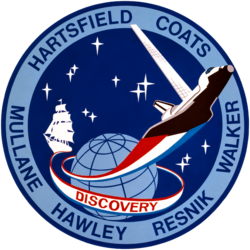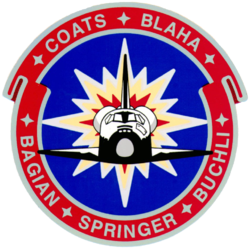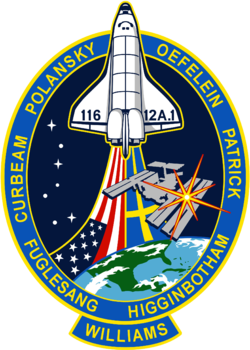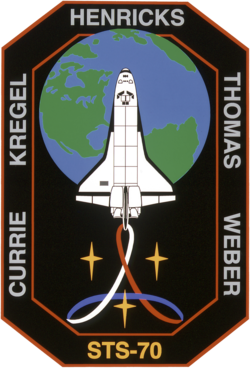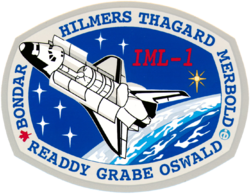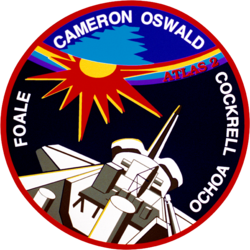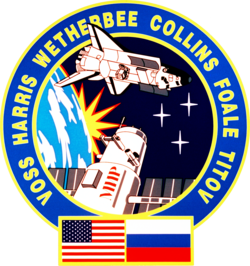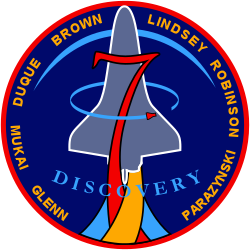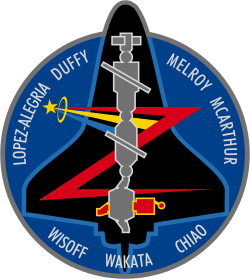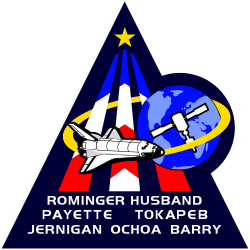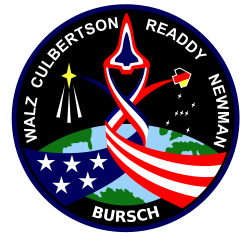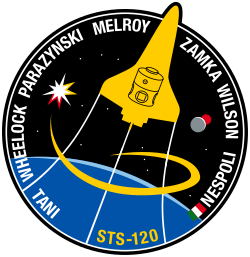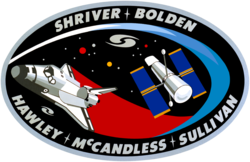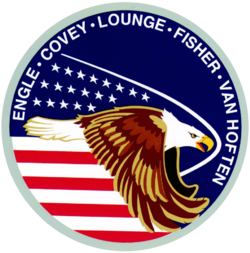Discovery (Raumfähre)


Die Raumfähre Discovery (englisch für Entdeckung) wurde am 12. August 1983 fertiggestellt und startete zu ihrem Jungfernflug am 30. August 1984 (STS-41-D). Die interne Bezeichnung für das Space Shuttle lautet OV-103, wobei OV für Orbiter Vehicle steht. Mit der Landung am 9. März 2011 beendete die Raumfähre ihre letzte Mission STS-133. Mit 39 Flügen ist die Discovery das am häufigsten eingesetzte Weltraumfahrzeug.
Geschichte
Die Discovery ist nach einem der Schiffe benannt, mit denen James Cook den Pazifik befuhr und 1778 Hawaii entdeckte.
Mit 39 Flügen absolvierte die Discovery mehr Flüge als alle übrigen Orbiter. Außerdem wurde sie jeweils für den ersten Flug nach den Unglücken der Challenger und der Columbia ausgewählt.
1990 transportierte die Discovery das Hubble-Weltraumteleskop ins All.
Große Beachtung fand 2005 die Mission STS-114, der erste Flug eines Shuttles nach der Columbia-Katastrophe im Jahr 2003. Auch dieser Flug wurde von einigen Pannen begleitet, was erneut zur Aussetzung der Shuttle-Flüge führte.
Im Juli 2006 absolvierte die Discovery mit der Mission STS-121 erfolgreich einen weiteren Versorgungsflug zur Internationalen Raumstation (ISS).
Im Mai/Juni 2008 führte der Orbiter die Mission STS-124 durch. Das mit sieben Mann besetzte Shuttle dockte am 2. Juni 2008 an der ISS an. Hauptaufgabe der Mission war es, das japanische Labormodul Kibō zur ISS zu bringen. Außerdem brachte das Shuttle Ersatzteile zur Reparatur der defekten Weltraumtoilette in der ISS mit.
Am 29. August 2009 startete die Discovery mit dem Multi-Purpose Logistics Module Leonardo zur ISS, um dort Vorräte und Material anzuliefern.
Am 24. Februar 2011 um 22:53 Uhr startete das Shuttle nach 27 Dienstjahren mit STS-133 zum letzten Mal. Am 26. Februar 2011, 20:14 Uhr, dockte sie an der ISS an und landete am 9. März 2011 um 17:57 Uhr zum letzten Mal auf der Landebahn des Kennedy Space Center in Florida.[1] Die Discovery ist mit 238,5 Millionen Kilometern die am weitesten gereiste Raumfähre der NASA-Shuttleflotte.



Seit dem 19. April 2012 steht die Discovery als Museumsstück im James S. McDonnell Space Hangar im Steven F. Udvar-Hazy Center des Smithsonian-Instituts in der Nähe vom Washington Dulles International Airport. Dort hat sie den Prototyp der Space Shuttles, die Enterprise, ersetzt.
Missionen
| Nr. | Start | Bezeichnung | Emblem | Besatzung |
|---|---|---|---|---|
| 1 | 30. August 1984 | STS-41-D | Henry Hartsfield, Michael Coats, Judith Resnik, Steven Hawley, Richard Mullane, Charles Walker | |
| 2 | 8. November 1984 | STS-51-A | Frederick Hauck, David Walker, Anna Fisher, Dale Gardner, Joseph Allen | |
| 3 | 24. Januar 1985 | STS-51-C | Thomas Mattingly, Loren Shriver, James Buchli, Ellison Onizuka, Gary Payton | |
| 4 | 12. April 1985 | STS-51-D | Karol Bobko, Donald Williams, Rhea Seddon, Jeffrey Hoffman, David Griggs, Charles Walker, Jake Garn | |
| 5 | 17. Juni 1985 | STS-51-G | Daniel Brandenstein, John Creighton, Shannon Lucid, John Fabian, Steven Nagel, Patrick Baudry, Salman bin Abdulaziz Al Saud | |
| 6 | 27. August 1985 | STS-51-I | Joe Engle, Richard Covey, James van Hoften, John Lounge, William Fisher | |
| 7 | 29. September 1988 | STS-26 | Frederick Hauck, Richard Covey, John Lounge, George Nelson, David Hilmers | |
| 8 | 13. März 1989 | STS-29 | Michael Coats, John Blaha, James Bagian, James Buchli, Robert Springer | |
| 9 | 23. November 1989 | STS-33 | Frederick Gregory, John Blaha, Story Musgrave, Manley Carter, Kathryn Thornton | |
| 10 | 24. April 1990 | STS-31 | Loren Shriver, Charles Bolden, Steven Hawley, Bruce McCandless, Kathryn Sullivan | |
| 11 | 6. Oktober 1990 | STS-41 | Richard Richards, Robert Cabana, William Shepherd, Bruce Melnick, Thomas Akers | |
| 12 | 28. April 1991 | STS-39 | Michael Coats, Blaine Hammond, Guion Bluford, Gregory Harbaugh, Richard Hieb, Donald McMonagle, Charles Veach | |
| 13 | 12. September 1991 | STS-48 | John Creighton, Kenneth Reightler, James Buchli, Charles Gemar, Mark Brown | |
| 14 | 22. Januar 1992 | STS-42 | Ronald Grabe, Stephen Oswald, Norman Thagard, David Hilmers, William Readdy, Roberta Bondar, Ulf Merbold | |
| 15 | 2. Dezember 1992 | STS-53 | David Walker, Robert Cabana, Guion Bluford, James Voss, Michael Clifford | |
| 16 | 8. April 1993 | STS-56 | Kenneth Cameron, Stephen Oswald, Michael Foale, Kenneth Cockrell, Ellen Ochoa | |
| 17 | 12. September 1993 | STS-51 | Frank Culbertson, William Readdy, James Newman, Daniel Bursch, Carl Walz | |
| 18 | 3. Februar 1994 | STS-60 | Charles Bolden, Kenneth Reightler, Jan Davis, Ronald Sega, Franklin Chang-Diaz, Sergei Krikaljow | |
| 19 | 9. September 1994 | STS-64 | Richard Richards, Blaine Hammond, Jerry Linenger, Susan Helms, Carl Meade, Mark Lee | |
| 20 | 3. Februar 1995 | STS-63 | James Wetherbee, Eileen Collins, Michael Foale, Janice Voss, Bernard Harris, Wladimir Titow | |
| 21 | 13. Juli 1995 | STS-70 | Terence Henricks, Kevin Kregel, Nancy Currie, Donald Thomas, Mary Weber | |
| 22 | 11. Februar 1997 | STS-82 | Kenneth Bowersox, Scott Horowitz, Mark Lee, Steven Hawley, Gregory Harbaugh, Steven Smith, Joseph Tanner | |
| 23 | 7. August 1997 | STS-85 | Curtis Brown, Kent Rominger, Jan Davis, Robert Curbeam, Stephen Robinson, Bjarni Tryggvason | |
| 24 | 2. Juni 1998 | STS-91 | Charles Precourt, Dominic Gorie, Wendy Lawrence, Franklin Chang-Diaz, Janet Kavandi, Waleri Rjumin | |
| 25 | 29. Oktober 1998 | STS-95 | Curtis Brown, Steven Lindsey, Scott Parazynski, Stephen Robinson, Pedro Duque, Chiaki Mukai, John Glenn | |
| 26 | 27. Mai 1999 | STS-96 | Kent Rominger, Rick Husband, Daniel Barry, Tamara Jernigan, Ellen Ochoa, Julie Payette, Waleri Tokarew | |
| 27 | 20. Dezember 1999 | STS-103 | Curtis Brown, Scott Kelly, Steven Smith, Michael Foale, John Grunsfeld, Claude Nicollier, Jean-François Clervoy | |
| 28 | 11. Oktober 2000 | STS-92 | Brian Duffy, Pamela Melroy, Leroy Chiao, Michael López-Alegría, William S. McArthur, Kōichi Wakata, Peter Wisoff | |
| 29 | 8. März 2001 | STS-102 | James Wetherbee, James Kelly, Paul Richards, Andrew Thomas | |
| 30 | 10. August 2001 | STS-105 | Scott Horowitz, Frederick Sturckow, Daniel Barry, Patrick Forrester | |
| 31 | 26. Juli 2005 | STS-114 | Eileen Collins, James Kelly, Charles Camarda, Wendy Lawrence, Noguchi Sōichi, Stephen Robinson, Andrew Thomas | |
| 32 | 4. Juli 2006 | STS-121 | Steven Lindsey, Mark Kelly, Michael Fossum, Piers Sellers, Lisa Nowak, Stephanie Wilson, Thomas Reiter | |
| 33 | 10. Dezember 2006 | STS-116 | Mark Polansky, William Oefelein, Robert Curbeam, Nicholas Patrick, Joan Higginbotham, Christer Fuglesang | |
| 34 | 23. Oktober 2007 | STS-120 | Pamela Melroy, George Zamka, Scott Parazynski, Stephanie Wilson, Douglas Wheelock, Paolo Nespoli | |
| 35 | 31. Mai 2008 | STS-124 | Mark Kelly, Kenneth Ham, Karen Nyberg, Ronald Garan, Michael Fossum, Akihiko Hoshide | |
| 36 | 15. März 2009 | STS-119 | Lee Archambault, Dominic Antonelli, Joseph Acaba, Richard Arnold, John Phillips, Steven Swanson | |
| 37 | 29. August 2009 | STS-128 | Frederick Sturckow, Kevin Ford, John Olivas, Patrick Forrester, José Hernández, Christer Fuglesang | |
| 38 | 5. April 2010 | STS-131 | Alan Poindexter, James Dutton, Rick Mastracchio, Clayton Anderson, Dorothy Metcalf-Lindenburger, Stephanie Wilson, Naoko Yamazaki | |
| 39 | 24. Februar 2011 | STS-133 | Steven Lindsey, Eric Boe, Steve Bowen, Benjamin Drew, Michael Barratt, Nicole Stott |
Siehe auch
Weblinks
- Discovery (OV-103). Raumfahrer.net, 2. Februar 2002
- Discovery (OV-103). NASA (englisch)
- Discovery in der Encyclopedia Astronautica (englisch)
- Chronik der Raumfähre Discovery. NASASpaceflight.com, 22. Februar 2011 (englisch)
Einzelnachweise
- ↑ STS 133 Mission Updates. NASA, 26. Februar 2011, archiviert vom am 3. März 2011; abgerufen am 26. Februar 2011 (englisch).
Auf dieser Seite verwendete Medien
STS-41D Mission Insignia
- The official mission insignia for the 41-D Space Shuttle flight features the Discovery - NASA's third orbital vehicle - as it makes its maiden voyage. The ghost ship represents the orbiter's namesakes which have figured prominently in the history of exploration. The Space Shuttle Discovery heads for new horizons to extend that proud tradition. Surnames for the crewmembers of NASA's eleventh Space Shuttle mission encircle the red, white, and blue scene.
STS-29 Mission Insignia
The STS-29 patch was designed to capture and represent the energy and dynamic nature of this nation's space program as America continues to look to the future. The folded ribbon border, the first of its kind in the Shuttle patch series, gives a sense of three dimensional depth to the emblem. The stylistic orbital maneuvering system (ONS) burn symbolizes the powerful forward momentum of the Shuttle and a continuing determination to explore the frontiers of space. The colors of the U.S. flag are represented in the patch's basic red, white, and blue background. In the border, the seven stars between the STS-29 crew names are a tribute to the crew of Challenger.
Autor/Urheber: Smithsonian Institute, Lizenz: CC0
View of Space Shuttle Discovery (OV-103) (A20120325000), mated to a Boeing Model 747-100 NASA Shuttle Carrier aircraft, in flight over the National Air and Space Museum's Steven F. Udvar-Hazy Center, April 17, 2012.
STS-33 Mission Insignia
STS-60 crew patch
- The design of the crew patch for NASA's STS-60 mission depicts the Space Shuttle Discovery's on-orbit configuration. The American and Russian flags symbolize the partnership of the two countries and their crew members taking flight into space together for the first time. The open payload bay contains: the Space Habitation Module (Spacehab), a commercial space laboratory for life and material science experiments; and a Getaway Special Bridge Assembly in the aft section carrying various experiments, both deployable and attached. A scientific experiment to create and measure an ultra-vacuum environment and perform semiconductor material science – the Wake Shield Facility – is shown on the Remote Manipulator System (RMS) prior to deployment.
STS-41 Mission Insignia
Das STS-133 Missionsemblem basiert auf Skizzen des verstorbenen Künstlers Robert McCall, sie waren die letzten Werke seiner langen und herausragenden Karriere. Im Vordergrund steigt ein einsamer Orbiter in einen dunkelblauen Himmel über einer wirbelnden feurigen Rauchfahne auf. Ein Sternenregen umgibt den Orbiter und eine von oben beleuchtete Mondsichel formt den Hintergrund des Aufstiegs. Die Nummer der Mission, STS-133, schmückt die Mitte des Emblems und die Namen der Crewmitglieder sind auf einer himmelblauen Umfassung der Szene aufgezählt. Das Shuttle Discovery wird im Aufstieg auf einer flammenden Rauchsäule dargestellt, so als ob gerade eine Mission beginnt. Es ist jedoch nur der Orbiter, ohne die Feststoffraketen und den externen Tank, so wie am Missionsende. Dies kennzeichnet die Beendigung der betriebsfähigen Phase der Discovery und den Anfang ihrer neuen Rolle als Symbol des stolzen Vermächtnisses von NASA und Nation in der menschlichen Raumfahrt.
The STS-116 patch design signifies the continuing assembly of the International Space Station (ISS). The primary mission objective is to deliver and install the P5 truss element. The P5 installation will be conducted during the first of three planned spacewalks, and will involve use of both the shuttle and station robotic arms. The remainder of the mission will include a major reconfiguration and activation of the ISS electrical and thermal control systems, as well as delivery of Zvezda Service Module debris panels, which will increase ISS protection from potential impacts of micro-meteorites and orbital debris. In addition, a single expedition crewmember will launch on STS-116 to remain onboard the station, replacing an expedition crewmember that will fly home with the shuttle crew. The crew patch depicts the space shuttle rising above the Earth and ISS. The United States and Swedish flags trail the orbiter, depicting the international composition of the STS-116 crew. The seven stars of the constellation Ursa Major are used to provide direction to the North Star, which is superimposed over the installation location of the P5 truss on ISS. The NASA insignia design for shuttle space flights is reserved for use by the astronauts and other official use as the NASA Administrator may authorize. Public availability has been approved only in the form of illustrations by the various news media. When and if there is any change in this policy, which is not anticipated, such will be publicly announced.
Emblem of Nasa's STS-53 mission
- Designed by the crewmembers, the STS-53 insignia shows the Space Shuttle Discovery rising to new achievements as it trails the symbol of the Astronaut Office against a backdrop of the American flag. The five stars and three stripes also serve to symbolize the mission designation (STS-53) and America's continuing commitment to world leadership in space. The pentagonal shape of the patch represents the Department of Defense (DOD) and its support of the Space Shuttle Program. The band delineating the flag from space includes the four colors of the military services of the crewmembers. The names of the flight crewmembers are located along the border of the patch. They are Commander David M. Walker, Pilot Robert D. Cabana, Mission Specialist (MS) Guion S. Bluford, MS James S. Voss, and MS Michael R. U. Clifford. Each crewmember contributed to the design of the insignia.
Shuttle mission 51-G patch
- The STS-51G insignia illustrates the advances in aviation technology in the United States within a relatively short span of the twentieth century. The surnames of the crewmembers for the Discovery's mission appear near the center edge of the circular design.
The mission patch for STS-85 is designed to reflect the broad range of science and engineering payloads on the flight. The primary objectives of the mission were to measure chemical constituents in Earth's atmosphere with a free-flying satellite and to flight-test a new Japanese robotic arm designed for use on the International Space Station (ISS). STS-85 was the second flight of the satellite known as Cryogenic Infrared Spectrometers and Telescopes for the Atmosphere-Shuttle Pallet Satellite-2 CRISTA-SPAS-02. CRISTA, depicted on the right side of the patch pointing its trio of infrared telescopes at Earth's atmosphere, stands for Cryogenic Infrared Spectrometers and Telescopes for the Atmosphere. The high inclination orbit is shown as a yellow band over Earth's northern latitudes. In the Space Shuttle Discovery's open payload bay an enlarged version of the Japanese National Space Development Agency's (NASDA) Manipulator Flight Demonstration (MFD) robotic arm is shown. Also shown in the payload bay are two sets of multi-science experiments: the International Extreme Ultraviolet Hitchhiker (IEH-02) nearest the tail and the Technology Applications and Science (TAS-01) payload. Jupiter and three stars are shown to represent sources of ultraviolet energy in the universe. Comet Hale-Bopp, which was visible from Earth during the mission, is depicted at upper right. The left side of the patch symbolizes daytime operations over the Northern Hemisphere of Earth and the solar science objectives of several of the payloads.
STS-70 Mission Insignia
The STS-70 crew patch depicts the Space Shuttle Discovery orbiting Earth in the vast blackness of space. The primary mission of deploying a NASA Tracking and Data Relay Satellite (TDRS) is depicted by three gold stars. They represent the triad composed of spacecraft transmitting data to Earth through the TDRS system. The stylized red, white, and blue ribbon represents the American goal of linking space exploration to the advancement of all humankind.
STS-42 Mission Insignia
The STS-105 crew patch symbolizes the exchange of the Expedition Two and Expedition Three crews aboard the International Space Station. The three gold stars near the ascending Orbiter represent the U.S. commanded Expedition Three crew as they journey into space, while the two gold stars near the descending Orbiter represent the Russian commanded Expedition Two crew and their return to Earth. The plumes of each Orbiter represent the flags of the United States and Russia and symbolize the close cooperation between the two countries. The Astronaut Office symbol, a star with three rays of light, depicts the unbroken link between Earth and the newest and brightest star on the horizon, the International Space Station (ISS). The ascending and descending Orbiters form a circle that represents both the crew rotation and the continuous presence in space aboard the ISS. The names of the four astronauts who will crew Discovery are shown along the border of the patch. The names of the Expedition Three and Expedition Two crews are shown on the chevron at the bottom of the patch. The NASA insignia design for Shuttle flights is reserved for use by the astronauts and for other official use as the NASA Administrator may authorize. Public availability has been approved only in the form of illustrations by the various news media. When and if there is any change in this policy, which we do not anticipate, it will be publicly announced.
STS-56 Mission Insignia
Aufstieg der Raumfähre Atlantis am 2. Dezember 1988 mit der Mission STS-27.
STS-63 Mission Insignia
This is a printable version of space shuttle Discovery's orbiter tribute, or OV-103, which hangs in Firing Room 4 of the Launch Control Center at NASA's Kennedy Space Center in Florida. Discovery's accomplishments include the first female shuttle pilot, Eileen Collins, on STS-63, John Glenn's legendary return to space on STS-95, and the celebration of the 100th shuttle mission with STS-92. In addition, Discovery supported a number of Department of Defense programs, satellite deploy and repair missions and 13 International Space Station construction and operation flights. The tribute features Discovery demonstrating the rendezvous pitch maneuver on approach to the International Space Station during STS-114. Having accumulated the most space shuttle flights, Discovery's 39 mission patches are shown circling the spacecraft. The background image was taken from the Hubble Space Telescope, which launched aboard Discovery on STS-31 and serviced by Discovery on STS-82 and STS-103. The American flag and bald eagle represent Discovery's two Return to Flight missions -- STS-26 and STS-114 -- and symbolize Discovery's role in returning American astronauts to space. Five orbiter tributes are on display in the firing room, representing Atlantis, Challenger, Columbia, Endeavour and Discovery.
The STS-95 patch, designed by the crew, is intended to reflect the scientific, engineering, and historic elements of the mission. The Space Shuttle Discovery is shown rising over the sunlit Earth limb, representing the global benefits of the mission science and the solar science objectives of the Spartan Satellite. The bold number '7' signifies the seven members of Discovery's crew and also represents a historical link to the original seven Mercury astronauts. The STS-95 crew member John Glenn's first orbital flight is represnted by the Friendship 7 capsule. The rocket plumes symbolize the three major fields of science represented by the mission payloads: microgravity material science, medical research for humans on Earth and in space, and astronomy.
STS-64 Mission Insignia
Autor/Urheber: Smithsonian Institute, Lizenz: CC0
View of a wedge installed under Space Shuttle Discovery's (OV-103) (A20120325000) port wing for a boundary layer transition experiment on its final mission, June 24, 2013. Small black squares where sensors were attached for data collection are visible on nearby tiles.
STS-82 Mission Insignia
- STS-82 is the second mission to service the Hubble Space Telescope (HST). The central feature of the patch is HST as the crew members will see it through Discovery's overhead windows when the orbiter approaches for rendezvous, retrieval and a subsequent series of spacewalks to perform servicing tasks. The telescope is pointing toward deep space, observing the cosmos. The spiral galaxy symbolizes one of HST's important scientific missions, to accurately determine the cosmic distance scale. To the right of the telescope is a cross-like structure known as a gravitational lens, one of the numerous fundamental discoveries made using HST Imagery. The names of the STS-82 crew members are arranged around the perimeter of the patch with the extravehicular activity's (EVA) participating crew members placed in the upper semicircle and the orbiter crew in the lower one.
Designed by the crew members, the STS-92 patch symbolizes the second mission to carry U.S.-built elements to the International Space Station (ISS) for assembly. The black silhouette of the Space Shuttle Discovery stands out against the deep blue background of space in low Earth orbit. In the foreground in gray is a profile view of the ISS as it appears when the shuttle and crew arrive, with the station consisting of the Unity node, its two pressurized mating adapters (PMA), the Zarya functional cargo block, the Zvezda service module, and the Progress cargo vehicle.
Following the shuttle's rendezvous and docking, the ISS configuration will be augmented by the two elements delivered by Discovery–the Z1 truss and PMA-3. These two elements, depicted in red, will be installed using the shuttle's robot arm and be connected to ISS during four spacewalks. The multi-national nature of both the STS-92 crew and the ISS are reflected in the multi-colored Astronaut Office symbol.
Designed by the crew members, this is the mission insignia for the STS-96 space flight, the second Space Shuttle mission dedicated to the assembly of the International Space Station (ISS). The crew patch highlights the major themes of the Station Program: Earth-directed research, the advancement of human space exploration, and international cooperation. The Space Shuttle Discovery is depicted shortly after reaching orbit as the crew prepares to carry out the first docking with the new Station. At this early stage in its construction, ISS consists of two modules: Zarya and Unity, shown orbiting Earth. The triangular shape of the patch represents building on the knowledge and experience of earlier missions, while the three vertical bars of the astronaut emblem point toward future human endeavors in space. The five-pointed star that tops the astronaut emblem in this depiction is symbolic of the five space agencies participating in the development of ISS: NASA, the Russian Space Agency, the European Space Agency, the National Space Development Agency of Japan, and the Canadian Space Agency. The blend of red, white, and blue is a tribute to the nationalities of the crew members who are from the United States, Canada, and Russia.
Emblem of Nasa's STS-114 mission.
- The STS-114 patch design signifies the return of the Space Shuttle to flight and honors the memory of the STS-107 Columbia crew. The blue Shuttle rising above Earth’s horizon includes the Columba constellation of seven stars, echoing the STS-107 patch and commemorating the seven members of that mission. The crew of STS-114 will carry the memory of their friends on Columbia and the legacy of their mission back into Earth orbit. The dominant design element of the STS-114 patch is the planet Earth, which represents the unity and dedication of the many people whose efforts allow the Shuttle to safely return to flight. Against the background of the Earth at night, the blue orbit represents the International Space Station (ISS), with the EVA crewmembers named on the orbit. The red sun on the orbit signifies the contributions of the Japanese Space Agency to the mission and to the ISS program. The multi-colored Shuttle plume represents the broad spectrum of challenges for this mission, including Shuttle inspection and repair experiments, and International Space Station re-supply and repair.
Emblem of Nasa's STS-51 mission.
The STS-120 patch reflects the role of the mission in the future of the space program. The shuttle payload bay carries Node 2, the doorway to the future international laboratory elements on the International Space Station. On the left the star represents the International Space Station; the red colored points represent the current location of the P6 solar array, furled and awaiting relocation when the crew arrives. During the mission, the crew will move P6 to its final home at the end of the port truss. The gold points represent the P6 solar array in its new location, unfurled and producing power for science and life support. On the right, the moon and Mars can be seen representing the future of NASA. The constellation Orion rises in the background, symbolizing NASA's new exploration vehicle. Through all, the shuttle rises up and away, leading the way to the future.
STS-31 shuttle mission flight insignia. The mission insignia for NASA's STS-31 mission features the Hubble Space Telescope (HST) in its observing configuration against a background of the universe it will study. The cosmos includes a stylistic depiction of galaxies in recognition of the contribution made by Sir Edwin Hubble to our understanding of the nature of galaxies and the expansion of the universe. The STS-31 crew points out that is it in honor of Hubble's work that this great observatory in space bears his name. The depicted Space Shuttle trails a spectrum symbolic of both the red shift observations that were so important to Hubble's work and new information which will be obtained with the HST. Encircling the art work, designed by the crew, are the names of its members.
The STS-102 crew insignia depicts the International Space Station as it looked when Space Shuttle Discovery was docked. Visible elements include the P6 and Z1 trusses, solar arrays from the Russian segment, 2 Pressurized Mating Adapters, and the Multi Purpose Logistics Module that was temporarily attached to the underside of the Unity Node. The numbers "102" represent the mission tail number. The red, white, and blue ribbons surrounding the space station represent that this is a crew rotation flight. The colors represent the nationalities of the crewmembers (Russian and American). Underneath the ribbons are the flags of the three nations who are the major contributors to the mission (from left to right: Russia, United States, Italy). The names of the 4 permanent crewmembers are displayed in gold around the top of the emblem. Attached to the bottom are six names depicting the six rotating crewmembers (Expedition 2 on top and Expedition 1 on bottom).
The STS-121 patch depicts the Space Shuttle docked with the International Space Station (ISS) in the foreground, overlaying the astronaut symbol with three gold columns and a gold star. The ISS is shown in the configuration that it will be in during the STS-121 mission. The background shows the nighttime Earth with a dawn breaking over the horizon. STS-121, ISS mission ULF1.1, is the final Shuttle Return to Flight test mission. This utilization and logistics flight will bring a multipurpose logistics module (MPLM) to the ISS with several thousand pounds of new supplies and experiments. In addition, some new orbital replacement units (ORUs) will be delivered and stowed externally on ISS on a special pallet. These ORUs are spares for critical machinery located on the outside of the ISS. During this mission the crew will also carry out testing of Shuttle inspection and repair hardware, as well as evaluate operational techniques and concepts for conducting on-orbit inspection and repair.
Das STS-128 Emblem symbolisiert die Mission 17A und repräsentiert die Geräte, das Volk und die Partnernationen, die zum Flug beitragen. Das Space Shuttle Discovery sieht man in der Orbitalkonfiguration mit dem Multi Purpose Logistics Module (MPLM) Leonardo in der Nutzlastbucht. Die Erde und die Internationale Raumstation wölben sich um das Symbol des Astronautenbüros, um uns an die fortgesetzte menschliche Präsenz im Weltraum zu erinnern. Die Namen der STS-128 Crewmitglieder säumen das Emblem in einer umwickelnden Weise. In die Namen einbezogen ist das Crewmitglied der ISS-Expedition, das mit STS-128 startet und an Bord der ISS bleibt und ein anderes Expeditionsmitglied ersetzt, welches mit STS-128 heimkehrt. Das Band vervollständigt auch das Symbol des Astronautenbüros und beinhaltet die amerikanischen und die schwedischen Flaggen, welche die Länder der STS-128 Crew repräsentieren.
Emblem of Nasa's STS-124 mission.
- The STS-124/1J patch depicts the Space Shuttle Discovery docked with the International Space Station (ISS). STS-124/1J is dedicated to delivering and installing the Japanese Experiment Module (JEM) known as Kibo (Hope) to the ISS. The significance of the mission and the Japanese contribution to the ISS is recognized by the Japanese flag depicted on the JEM Pressurized Module (JPM) and the word Kibo written in Japanese at the bottom of the patch. The view of the sun shining down upon the Earth represents the increased "hope" that the entire world will benefit from the JEM's scientific discoveries. The JPM will be the largest habitable module on the ISS and is equipped with its own airlock and robotic arm for external experiments. In addition to delivering and installing the JPM, the STS-124 crew will relocate the JEM Logistics Pressurized (JLP) module to its permanent home on the zenith side of the JPM. During three planned space walks, the crew will perform external ISS maintenance and JPM outfitting, as well as extensive robotic operations by the ISS, space shuttle, and JEM robotic arms. It will be the first time that three different robotic arms will be operated during a single space flight mission.
Autor/Urheber: Smithsonian Institute, Lizenz: CC0
View of Space Shuttle Discovery (OV-103) (A20120325000) on display in the James S. McDonnell Space Hangar at the National Air and Space Museum's Steven F. Udvar-Hazy Center, May 3, 2012. The Shuttle Remote Manipulator Arm (SRMS, Canadarm) is displayed in the foreground, under the Shuttle's left wing and the MMU (Manned Maneuvering Unit) can be seen floating above the flight deck windows.
The shape of the STS-119/15A patch comes from the shape of a solar array viewed at an angle. The International Space Station (ISS), which is the destination of the mission, is placed accordingly in the center of the patch just below the gold astronaut symbol. The gold solar array of the ISS highlights the main cargo and task of STS-119/15A -- the installation of the S6 truss segment and deployment of S6's solar arrays, the last to be delivered to the ISS. The surnames of the crew members are denoted on the outer band of the patch. The 17 white stars on the patch represent, in the crew's words, "the enormous sacrifice the crews of Apollo 1, Challenger, and Columbia have given to our space program." The U.S. flag flowing into the space shuttle signifies the support the people of the United States have given our space program over the years, along with pride the U.S. astronauts have in representing the United States on this mission.
Thousands of gallons of water released as part of the sound suppression system at the launch pad create clouds of steam and exhaust as Space Shuttle Discovery lifts off from Launch Pad 39B at 2:19 p.m. EST Oct. 29 on mission STS-95. Making his second voyage into space after 36 years is Payload Specialist John H. Glenn Jr., senator from Ohio. Other crew members are Mission Commander Curtis L. Brown Jr., Pilot Steven W. Lindsey, Payload Specialist Chiaki Mukai, (M.D., Ph.D.), with the National Space Development Agency of Japan (NASDA), Mission Specialist Stephen K. Robinson, Mission Specialist Pedro Duque of Spain, representing the European Space Agency (ESA), and Mission Specialist Scott E. Parazynski. The STS-95 mission includes research payloads such as the Spartan solar-observing deployable spacecraft, the Hubble Space Telescope Orbital Systems Test Platform, the International Extreme Ultraviolet Hitchhiker, as well as the SPACEHAB single module with experiments on space flight and the aging process. Discovery is expected to return to KSC at 11:49 a.m. EST on Nov. 7.
Das STS-131/19A Mannschaftsemblem hebt das Space Shuttle im Rendezvous Pitch Maneuver hervor. Dieses Manöver wird von den Astronauten der Internationalen Raumstation mit hoher Aufmerksamkeit fotografiert und die Fotos werden zurück auf der Erde analysiert, um das Hitzeschutzsystem des Space Shuttles klar für den Wiedereintritt zu machen. Das RPM veranschaulicht das Zusammenspiel und das Sicherheitsprozedere bei jedem Space Shuttle Start. Im Shuttlefrachtraum befindet sich das Multi-Purpose Logistics Module (MPLM) Leonardo, welches mehrere Wissenschaftsracks, das letzte von vier Wohnquartieren und Nachschub für die ISS beherbergt. Nicht im Blick und direkt hinter dem MPLM ist der Ammoniaktank (Ammonia Tank Assembly - ATA), welcher den gegenwärtigen Tank ersetzen wird. Das wird während drei Weltraumausstiegen (EVAs) geschehen. Der 51.6° Space Shuttle Orbit wird durch die drei goldenen Balken des Astronautensymbols illustriert und sein elliptischer Kranz beinhaltet die Bahn der ISS. Der Stern auf dem Astronautensymbol ist die dämmernde Sonne, welche ihr frühes Licht über die Erde ausbreitet. Das Hintergrundsternenfeld beinhaltet sieben Sterne, einen für jedes Crewmitglied, die während der Mission mit Stolz die Vereinigten Staaten und Japan repräsentieren.
Designed by the crewmembers, the STS-103 emblem depicts the Space Shuttle Discovery approaching the Hubble Space Telescope (HST) prior to its capture and berthing. The purpose of the mission is to remove and replace some of the Telescope's older and out-of-date systems with newer, more reliable and more capable ones, and to make repairs to HST's exterior thermal insulation that has been damaged by more than nine years of exposure to the space environment. The horizontal and vertical lines centered on the Telescope symbolize the ability to reach and maintain a desired attitude in space, essential to the instrument's scientific operation. The preservation of this ability is one of the primary objectives of the mission. After the flight, the Telescope will resume its successful exploration of deep space and will continue to be used to study solar system objects, stars in the making, late phases of stellar evolution, galaxies and the early history of the universe. HST, as represented on this emblem was inspired by views from previous servicing missions, with its solar arrays illuminated by the Sun, providing a striking contrast with the blackness of space and the night side of Earth.
- The NASA insignia design for Shuttle flights is reserved for use by the astronauts and for other official use as the NASA Administrator may authorize. Public availability has been approved only in the form of illustrations by the various news media. When and if there is any change in this policy, which is not anticipated, it will be publicly announced.
Emblem of Nasa's STS-39 mission.
The predominant themes are: a new beginning (sunrise), a safe mission (stylized launch and plume), the building upon the traditional strengths of NASA (the red vector which symbolizes aeronautics on the original NASA insignia), and a remembrance of their seven colleagues who died aboard Challenger (the seven-starred Big Dipper). The patch was designed by artist Stephen R. Hustvedt of Annapolis, MD.
The crew insignia for STS Flight 51-C includes the names of its five crewmembers. The STS 51-C mission marked the third trip of the Space Shuttle Discovery into space. It was the first Space Shuttle mission totally dedicated to the Department of Defense. The U. S. Air Force Inertial Upper Stage Booster Rocket was successfully deployed. Due to the nature of the mission, few additional details of the flight were made available. Landing was made at the Kennedy Space Center, FL on January 27 at 4:23 PM EST. Mission duration was three days, one hour and 33 minutes.
This is the crew patch for the STS-91 mission – the ninth flight of the Shuttle-Mir Phase One docking missions. The crew will bring back Andrew S. W. Thomas, the last long-duration American crew member flown on the Russian Space Station Mir. This mission marks the end of the Shuttle-Mir Phase One Program and will open the way for Phase Two: construction of the International Space Station (ISS).
The crew patch depicts the rendezvous of the Space Shuttle Discovery with the Space Station Mir. The flags of the United States and Russia are displayed at the top of the patch and both countries are visible on the Earth behind the two spacecraft. The names of the American crew members surround the insignia on the outer areas, with the name of cosmonaut Valeriy Ryumin in Cyrillic at the lower right.
STS-48 Mission Insignia
- Designed by the astronaut crewmembers, the STS 48 patch represents the Space Shuttle Orbiter Discovery in orbit about the Earth after deploying the Upper Atmospheric Research Satellite (UARS) depicted in block letter style. The stars are those in the Northern Hemisphere as seen in the fall and winter when UARS will begin its study of Earth's atmosphere. The color bands on Earth's horizon, extending up to the UARS spacecraft, depict the study of Earth's atmosphere. The triangular shape represents the relationship among the three atmospheric processes that determine upper atmospheric structure and behavior: chemistry, dynamics and energy. In the words of the crewmembers, This continuous process brings life to our planet and makes our planet unique in the solar system."

